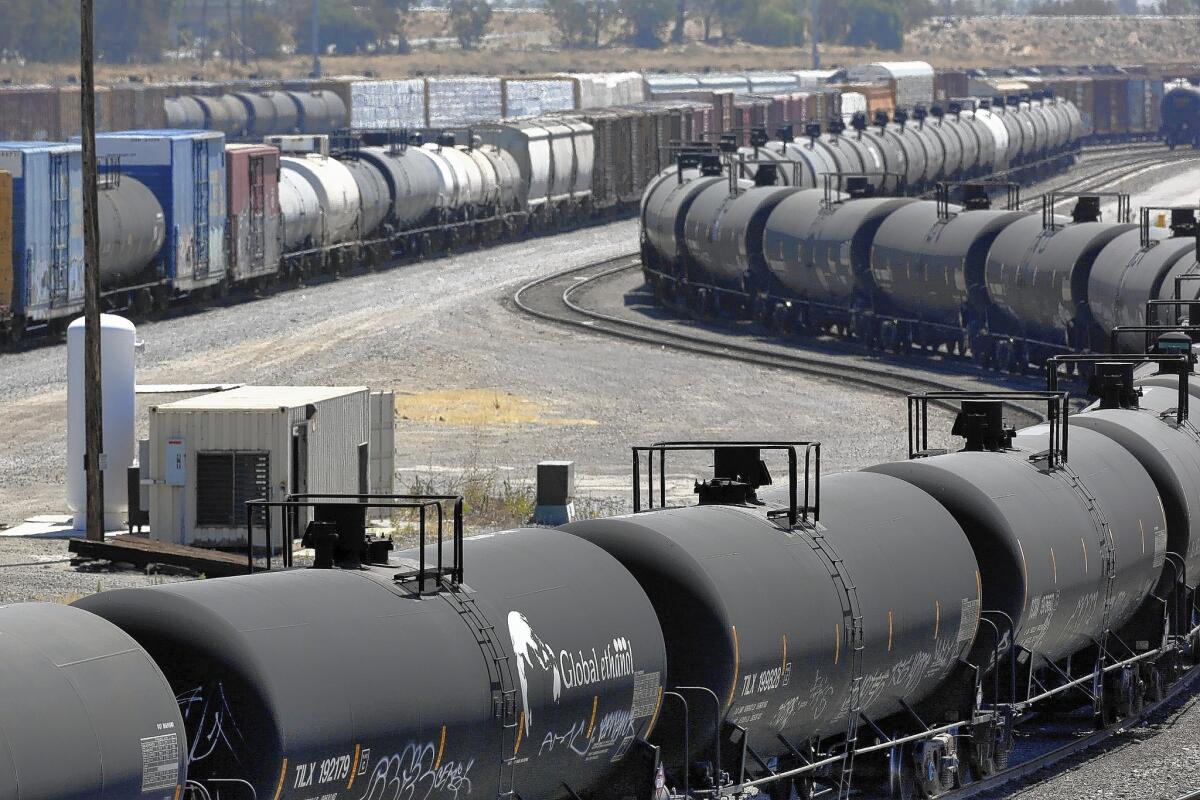State moves to improve safety in transporting oil by rail

- Share via
Reporting from SACRAMENTO — A year after rail tanker cars carrying crude oil in Canada exploded and killed 47 people, California is stepping up efforts to prevent a similar disaster on tracks crisscrossing the state.
In recent weeks, the state began pumping more money into a new rail safety program, the Legislature approved new fees on oil being carried by train, and the state’s Fish and Wildlife Department started planning how to better protect inland waterways from oil spills.
“We have a clear and present risk to Californians right now from potential spills,” said Chuck Bonham, Fish and Wildlife director. “We’re moving fast per the Legislature to best prepare California for that risk.”
There’s good reason for rushing, Bonham warned. Crude oil shipments to California last year rose to 6.3 million barrels, up 1.1 million barrels from the 2012 total. Imports could rise to 150 million 42 gallon barrels, a quarter of the state total, by 2016, the California Energy Commission estimates.
The Fish and Wildlife Department, which oversees the state’s Office of Oil Spill Prevention and Response, is set to hire 38 technicians to boost a current crew of 250 people, previously funded to deal mainly with coastal oil spills.
Top Fish and Wildlife officials already are meeting with other federal, state and local government agencies to set priorities and schedule a series of emergency response drills at high-risk stretches of rail lines, such as in the mountains, marshlands and densely populated urban neighborhoods.
The new hires and expanded responsibility will be paid for by a fee of 6.5 cents per barrel of crude oil transported through the state by rail or pipeline. The fees were approved by the Legislature in mid-June after a heated battle between California’s powerful oil industry, the administration of Gov. Jerry Brown and environmentalists.
The governor basically got what he wanted: a dedicated source of money to help respond quickly to both maritime spills and potential and actual accidents involving pipelines and rail tanker cars bringing crude oil to refineries from in-state wells and fields in the Great Plains and Canada.
But that’s just part of the state’s response to the threat posed by train wrecks involving crude oil cargoes. The state Public Utilities Commission is hiring seven additional track inspectors to work with federal government counterparts to keep oil trains with up to 100 tank cars rolling safely.
And lawmakers still are considering even more measures to require railroads to provide greater information about oil trains passing through communities, establish round-the-clock emergency communications, and levy per-tank-car fees for emergency response activities.
“The funding in the budget is an important step,” said Sen. Fran Pavley (D-Agoura Hills), author of one of three tank-car-safety bills, “but more actions can be taken to help prevent and respond to accidents.”
The Brown administration’s goal is to set up a comprehensive system for safeguarding an estimated 7,000 rail and 5,000 pipeline crossings over inland waters.
With that in mind, Fish and Wildlife already has hosted a number of meetings with state and federal government agencies, including the State Fire Marshal and the U.S. Coast Guard, that also deal with oil spills. State officials are reaching out to railroad companies and tank car manufacturers, who are working on more crash-resistant rolling stock.
“The folks who transport oil and store oil in appreciable volume need to develop contingency plans for how to protect sensitive sites,” said Thomas Cullen, a former Coast Guard captain, who runs the state’s prevention and response program.
Plans also call for safety drills and, possibly, the placement of safety equipment at potentially dangerous rail “pinch points.”
These points include spots along rail routes through the Feather River Canyon and Donner Pass in Northern California, the Tehachapi Pass and San Luis Obispo in the central part of the state, and urban rail corridors in Southern California, officials said.
“We’ve got to go shoulder-to-shoulder working with industry,” Cullen said.
One of the first steps, he said, will be issuing emergency regulations for rail and pipeline oil transportation, which he hopes can happen by September.
Officials said permanent regulations should be ready about a year later, after Fish and Wildlife holds hearings to get input from railroads, oil companies, environmentalists, local government agencies and neighborhood groups.
Oil companies, which had opposed some parts of the governor’s program, including the fee for inland shipments, say they want to cooperate with the state’s expanding safety efforts.
“It’s going to add some additional expense to getting California energy to consumers,” said Tupper Hull, a spokesman for the Western States Petroleum Assn., a trade group.
“Our primary concern,” he said, is to see that state money goes to first responders “to give them the equipment and training necessary so people can have confidence that this is a safe transportation mode.”
Twitter: @MarcLifsher
More to Read
Inside the business of entertainment
The Wide Shot brings you news, analysis and insights on everything from streaming wars to production — and what it all means for the future.
You may occasionally receive promotional content from the Los Angeles Times.











